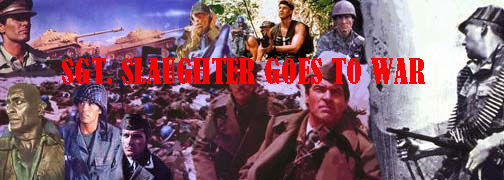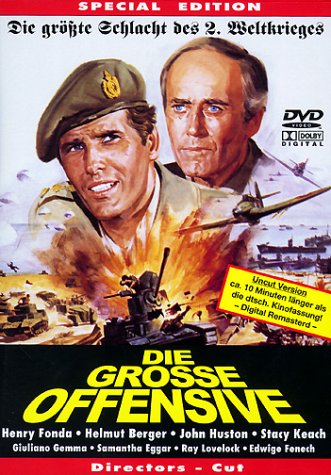
BATTLE FORCE (1978)

DIRECTOR:
Umberto Lenzi
CAST:
Stacy Keach,
Henry Fonda,
John Huston,
Helmut Berger,
Ray Lovelock,
Giuliano Gemma,
Samantha Eggar,
Edwige Fenech,
Ida Galli,
Geoffrey Copleston,
Giacomo Rossi-Stuart,
Pierangelo Civera,
Emilio Delle Piane,
Rik Battaglia,
Marco Guglielmi,
Mirko Ellis,
Luciano Catenacci,
Andrea Bosic,
Aldo Massasso,
Guy Doleman,
Robert Spafford,
Bill Vanders,
Tom Felleghy,
Giuseppe Castellano,
Franco Odoardi,
Fulvio Mingozzi,
Giovanni Cianfriglia,
Aldo Barberito,
Max Tarilli, Massimo Bonetti,
Attilio Dotessio,
Venantino Venantini,
Michele Soavi,
Manfred Freyberger and Orson Welles.
REVIEW:
Director Umberto Lenzi’s movies have always been the subject of criticism on web boards and even from nationally known reviewers, including Leonard Maltin. It seems as though he takes a lot of flak simply because his films are made overseas. At its heart, “The Greatest Battle” is really no better or worse than the slew of epic war films to come out of Hollywood in the 1970s.
During the Berlin Olympics of 1936, German Major Roland (Stacy Keach); American General Foster (Henry Fonda); reporter Sean O’Hara (John Huston) and Jewish actress Annelise Ackerman (Samantha Eggar) meet and become friends. Flash forward to late 1941: America is embroiled in World War II. Several more characters are introduced, namely: Foster’s loser son, John (Ray Lovelock); gutsy British commando leader Captain Scott (Giuliano Gemma) and dedicated Nazi commando officer Lt. Zimmer (Helmut Berger). All of these characters become interconnected over the course of the next two years and wind up coming face-to-face at the Battle of the Mareth Line in North Africa. Each turn in a dedicated, honest performance – something to be admired in this genre.
Several familiar European actors appear in the supporting cast, and although their parts are unimportant to the storyline, it’s essential to mention some of them: Giacomo Rossi-Stuart (“Hornet’s Nest”) plays John Foster’s commander; Andrea Bosic (“Hell’s Brigade”) as the leader of Greek partisans; Ida Galli (“Eagles Over London”) as Scott’s estranged wife, and Venantino Venantini (“The War Devils”) as her new husband; Geoffrey Copleston (“The Assisi Underground”) as a menacing SS Colonel; Luciano Catenacci (“The Battle of El Alamein”) as a British radio operator; the list goes on forever. Even Orson Welles (“The Battle of Neretva”) narrates the proceedings rather unnecessarily – and, often, incorrectly.
For the most part, this is a plotless series of scenes, chronicling major events in the characters’ lives and campaigns. Lenzi fills out the running time with stylistic action sequences and well-integrated stock footage. Lenzi’s directorial style and energy are apparent in a number of battle scenes. He takes a lot of ideas and scenarios from his earlier war films – notably, “Battle of the Commandos” (a partisan ambush of a German armored convoy looks awfully familiar, as does a commando raid on a coastal bunker) and shoots them with a bigger budget and more professionalism. The Federico Zanni photography is simply dazzling and excellently edited by Eugenio Alabiso, one of my favorite genre-editors.
Unfortunately, a lot of familiar stock footage from “Battle of the Commandos”, “Commandos”, “Desert Assault” and “The Battle of El Alamein” is used as a substitute for original action footage, which really hampers the original, epic feel of the movie. But look at Hollywood’s epic “Midway”, released in 1976: it’s a hodgepodge of stock footage and cameos, yet is much better received by audiences than this film. The major action sequences revolve solely around the stock footage, but that’s okay in this movie, because the material surrounding these sequences is so good.
The production values are amazingly high in this film, setting it another notch among its’ peers. The sets, from Parisian bars and brothels, to huge entrenchments, fuel dumps and railroad stations look fantastic. The costumes and props are appropriate, too. There are hundreds of extras, tanks, APCs, jeeps and airplanes dotting the screen, giving the film the appropriate epic look.
This Italian-produced war epic is typically underrated and undeserving of the criticism it so often receives. While it does lack a storyline and has no character development whatsoever… and contains reels of stock footage, the original material, style and slew of actors help to offset these flaws. “The Greatest Battle” is no better or worse than any similar film made in Hollywood, and is certainly much more entertaining and engaging than titles like “Midway”.
RATING:
3 Bullets
Best Bet to Watch this Flick:
“The Greatest Battle” NTSC VHS from HBO Home Video (out of print)